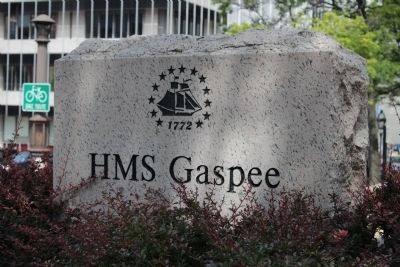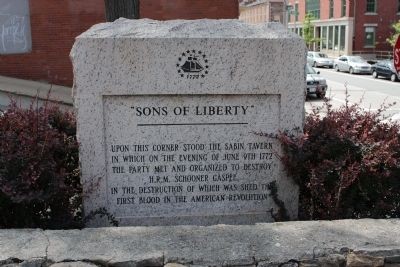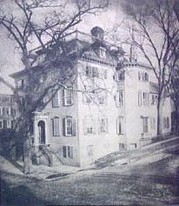HMS Gaspee Historic Marker
Introduction
Text-to-speech Audio
Images
Gaspee Historic Marker Side 1 (image from Historical Markers Database)

Gaspee Historic Marker Side 2 (image from Historical Markers Database)

The Sabin Tavern c1880. The room where the Gaspee Raiders met can be seen behind the tree on the right side of the picture. The octagonal end of the room, while not original, marks its location. (image from Providence Public Library Collection)

Backstory and Context
Text-to-speech Audio
This historical marker stands on the site of the Sabin Tavern, where, in 1772 (18 months before the Boston Tea Party), colonists of Providence, Rhode Island planned their attack on the H.R.M. Gaspee, a British navy schooner. The Gaspee was stationed nearby at Newport, with orders to seize ships suspected of smuggling illegal or untaxed cargo in Narragansett Bay. Under the command of Lieutenant William Dudingston, the crew of the Gaspee interpreted their orders as a license to steal supplies and livestock from both ships and coastal communities in the bay area. As a final straw, the American vessel Fortune was captured, its cargo of rum illegally seized, and its captain, Rufus Greene, beaten. Greene attempted to sue, and the colonists issued a warrant for Dudingston's arrest. When Britain failed to respond to the colonists' satisfaction, an attack on the Gaspee was planned.
The Sabin Tavern was built in 1763, and quickly became the most frequented hostelry in Providence thanks to its proximity to Fenner's Wharf. The planning of the attack took place in the southeast room of the tavern on June 9, 1772. The attacking party included members of the Sons of Liberty, a loosely organized group of anti-British colonists including prominent politicians and publishers, with chapters in New York, Boston, Providence, and other American cities. Prominent locals including Stephen Hopkins, John Cole, and Moses Brown and his brothers John and Jacob appear to have had knowledge of the attack ahead of time, based on correspondence with Samuel Adams (who was a Son of Liberty). Also involved were many Providence merchants (most involved in the distillation and trade of alcohol, particularly rum and gin), who were eager to stabilize trade by helping to destroy the Gaspee.
The attack was carefully planned, accounting for tides, harbor conditions, and the dismissal of the Gaspee's pilot (who was familiar with the harbor) several weeks prior to the attack. Captain Benjamin Lindsey of the colonial ship Hannah departed from Fenner's Wharf on the evening of June 9, 1772, and lured the Gaspee around Namquid Point, into the shallows where Dudingston's ship ran aground. Lindsey reported back to the Sabin Tavern around 5 pm, coordinating with John Brown and Abrahm Whipple, who organized the raid on the trapped British vessel. The attack occurred at 12:45 am on June 10th, at moonset, the darkest part of the night. The crew of the Gaspee were captured, Dudingston was shot (in the groin, though he survived), and the ship was burned to the waterline.
The British Crown set up a "kangaroo court" to send suspects back to England for trial, and offered a substantial reward for the names of the attackers, but the colonists maintained unified silence. The "Gaspee Affair" and the British response prompted the formation of the Committees of Correspondence and, subsequently, prompted Virginia leadership to call for the First Continental Congress. Thomas Jefferson, in fact, cited the latter as a direct result of the Gaspee Affair. Already furious with the British Crown for unfair taxation without representation, the colonies needed only one event to move toward unification; that event was the burning of the Gaspee.
Inscription:
[Side 1]
1772
HMS Gaspee
[Side 2]
1772
"Sons of Liberty"
Upon this corner stood the Sabin Tavern
in which on the evening of June 9th 1772
the party met and organized to destroy
the H.R.M. schooner Gaspee,
in the destruction of which was shed the
first blood in the American Revolution
